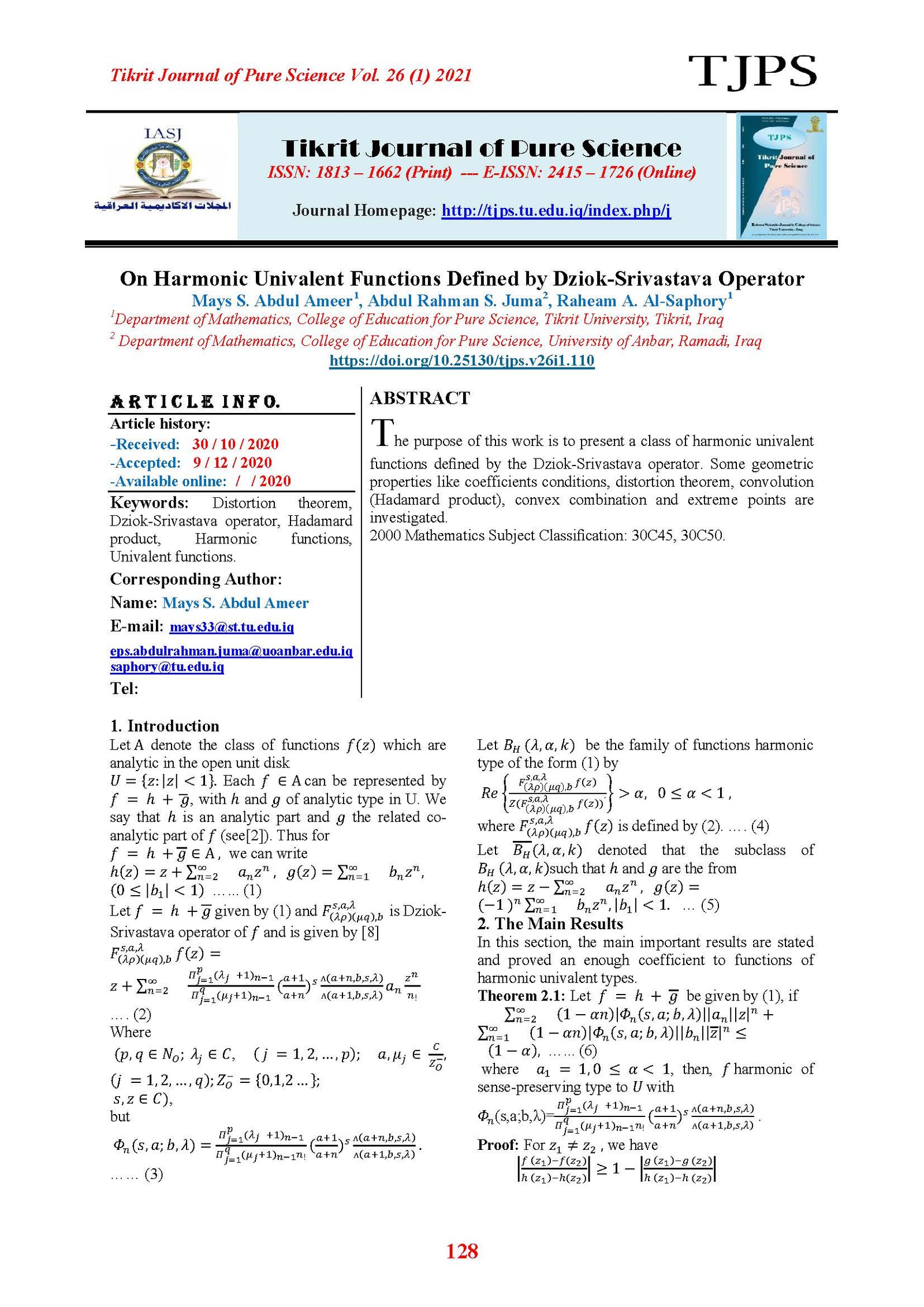On Harmonic Univalent Functions Defined by Dziok-Srivastava Operator
Main Article Content
Abstract
The purpose of this work is to present a class of harmonic univalent functions defined by the Dziok-Srivastava operator. Some geometric properties like coefficients conditions, distortion theorem, convolution (Hadamard product), convex combination and extreme points are investigated.
2000 Mathematics Subject Classification: 30C45, 30C50
Article Details

This work is licensed under a Creative Commons Attribution 4.0 International License.
Tikrit Journal of Pure Science is licensed under the Creative Commons Attribution 4.0 International License, which allows users to copy, create extracts, abstracts, and new works from the article, alter and revise the article, and make commercial use of the article (including reuse and/or resale of the article by commercial entities), provided the user gives appropriate credit (with a link to the formal publication through the relevant DOI), provides a link to the license, indicates if changes were made, and the licensor is not represented as endorsing the use made of the work. The authors hold the copyright for their published work on the Tikrit J. Pure Sci. website, while Tikrit J. Pure Sci. is responsible for appreciate citation of their work, which is released under CC-BY-4.0, enabling the unrestricted use, distribution, and reproduction of an article in any medium, provided that the original work is properly cited.
References
[1] Clunie J., Sheil T. (1984). Harmonic univalent functions, Ann. Acad. Sci. Fenn. Ser. A. I. Math.,vol. 9, pp 3-25.
[2] Cotirla L. I. (2009). Harmonic univalent functions defined by an integral operator, A. Univ. Apul., pp95-105.
[3] Gregorczyk M., Widomski J. (2010). Harmonic mappings in the exterior of the unit disk, annales universitatis mariae curie-sklodowska, Vol. lxiv, no. 1, pp63-73.
[4] Janangiri J.M. (1999). Harmonic functions starlike in the unit disc, J. Math. Anal. Appl.,
Vol. 235, pp470–447.
[5] Juma A. R. S. (2010). On harmonic univalent function defined by generalized Salagean derivatives, acta, no.2 3, ,179-188.
[6] Juma A. R. S. and. Kulkarni S. R. (2007). On univalent functions with negative coefficients by using generalized Salagean operator, Filomat, Vol. 21,173-184.
[7] Srivastava H. M. and Gaboury S. (2015). A new class of analytic functions defined by means of a generalization of the Srivastava-Attiya Operator, J. Inequal. Appl. 2015, Article ID 39,
pp1–15.
[8] Srivastava H. M., Juma A. R. S. and Zayed H. M. (2018). On Univalence conditions for an integral operator defined by a generalization of the Srivastava-Attiya operator. Filomat, vol. 32. no. 6, pp2101–2114.
[9] Mahmoud M., Juma A. R. and Al-Saphory R., On bi-univalent functions involving Srivastava-Attiya operator, Italian Journal of Pure and Applied Mathematics, Accepted 2020.
[10] Abdul Ameer M., Juma A. R. and Al-Saphory R., Differential Subordination for Higher-Order Derivatives of Multivalent Functions, Journal of Physics: Conference Series, Accepted 2020.
[11] Abdul Ameer M., Juma A. R. and Al-Saphory R., Harmonic Multivalent Functions Defined by General Integral Operator, Al-Qadisiyah Journal of Pure Science, vol. 26, no. 1, ppMath 1-12, 2021.
